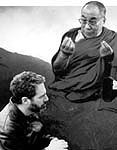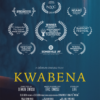
The Journey that Led to ‘The Jew in the Lotus’
Written by Holly Madden | Posted by: Anonymous
Chiten had accumulated a pile of debt filming a documentary that had taken five years to complete. “I was mentally and financially exhausted, and no one showed interest in buying the film. I felt like quitting the business altogether.” She decided to look for spiritual solace on the Internet. In particular, she was interested in why so many Jews were drawn to Buddhism. “I came across several websites which mentioned ‘The Jew In The Lotus.’ I decided to read the book and almost immediately, I envisioned a film.”
The book chronicles Rodger Kamenetz, a journalist who was invited by a friend to document an event he had organized in India. Jewish rabbis were meeting with the Dalai Lama of Tibet to share the Jewish secret of spiritual survival in exile. The Tibetans had lost their land to China, their temples, their religious leader, and now they feared they would lose their identity as a people. The timing of the event couldn’t have been worse for Kamenetz. He was troubled by the recent death of his infant and his writing career was floundering. Overcome with doubt and pain, he wasn’t even sure if he could rise to the occasion.
Read Interviews with other 1998 New England Film & Video Festival Award Winners…
Laura Colella
Flora Cohen
Jay Craven
Ellie Lee
Festival Schedule, Film Guide & Tickets
“While the book documents the meeting between the rabbis and the Dalai Lama and their comparison of Judaism and Buddhism, my film focuses on Rodger’s personal journey; how his meeting with the Dalai Lama changed his life,” she said. “To sum up the film we use the log line, ‘Sometimes you have to go far away to find your way back home.’”
In India, Kamenetz was surrounded by suffering and overwhelming poverty. Yet, the Dalai Lama and the Tibetan Buddhist faced their ordeal with resolve and compassion. “The experience was therapeutic for Rodger, because he learned that he was not alone in his suffering,” Chiten explains. “As he watched the Jewish delegates share their secrets, Rodger began to feel the power of spiritual tradition. His facade of cynicism and self-deprecation began to crack. He found a way out of his own pain, turned his attention away from himself, and looked for ways to help the Dalai Lama.”
The film took four years to complete and was shot primarily on 16mm film. “I also used Super 8, Beta and High 8 to give the film added texture,” she said. The film was primarily funded through a licensing agreement from PBS’s Independent Television Services; the Nathan Cummings Foundation in New York; the Kapor Family Foundation; as well as other small foundations and individuals. “I was lucky—I had a good-size budget to work with this time.” Her previous projects were all completed on shoestring budgets.
Before entering the film world, Chiten was a sign language interpreter with a degree in media and a background in theater. She got interested in film while tinkering with equipment at a Somerville public access station. In 1988, she completed her first major project entitled “Two In Twenty,” a five-part dramatic series Chiten describes as “a very kitsch, very playful social conscience opera.” The series was shown on public access TV and became a cult classic in the home video market. She followed this project in 1995 with “Twitch and Shout,” her Emmy-nominated documentary on people living with Tourette Syndrome. In 1987, Chiten was awarded the Artist’s Fellowship from the Massachusetts Council for the Arts and Humanities.
As for making documentaries vs. narrative films, Chiten explains that while narrative films reach a greater audience, documentaries have a longer shelf life. “The documentary has a 4-tier market: television, the educational market (such as universities and libraries), the home video market, and film festivals.”
Speaking of film festivals, Chiten’s film recently premiered to a packed house at the 1998 San Diego Jewish Film Festival. Audience members called the film “powerful” and complimented Chiten for “understanding the essence of the book.” It also won the award for “Most Outstanding Personal Vision” for the upcoming New England Film and Video Festival.
As for the next project on her plate, Chiten is taking a break from documentaries and hopes to make a narrative film some day. But for right now, she sighs, “I just want a life.”
The Jew in the Lotus will be screened at the NEFV Festival at the Coolidge Corner Theater on Thursday, April 2, and at the Museum of Fine Arts Boston, starting on March 19, with 15 screening dates thereafter. It is also scheduled for screening at the South by Southwest Film Festival in Austin, Texas.











